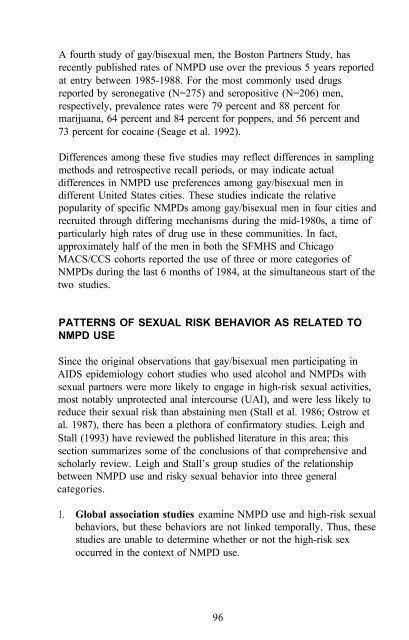The Context of HIV Risk Among Drug Users and Their Sexual Partners
The Context of HIV Risk Among Drug Users and Their Sexual Partners
The Context of HIV Risk Among Drug Users and Their Sexual Partners
You also want an ePaper? Increase the reach of your titles
YUMPU automatically turns print PDFs into web optimized ePapers that Google loves.
A fourth study <strong>of</strong> gay/bisexual men, the Boston <strong>Partners</strong> Study, has<br />
recently published rates <strong>of</strong> NMPD use over the previous 5 years reported<br />
at entry between 1985-1988. For the most commonly used drugs<br />
reported by seronegative (N=275) <strong>and</strong> seropositive (N=206) men,<br />
respectively, prevalence rates were 79 percent <strong>and</strong> 88 percent for<br />
marijuana, 64 percent <strong>and</strong> 84 percent for poppers, <strong>and</strong> 56 percent <strong>and</strong><br />
73 percent for cocaine (Seage et al. 1992).<br />
Differences among these five studies may reflect differences in sampling<br />
methods <strong>and</strong> retrospective recall periods, or may indicate actual<br />
differences in NMPD use preferences among gay/bisexual men in<br />
different United States cities. <strong>The</strong>se studies indicate the relative<br />
popularity <strong>of</strong> specific NMPDs among gay/bisexual men in four cities <strong>and</strong><br />
recruited through differing mechanisms during the mid-1980s, a time <strong>of</strong><br />
particularly high rates <strong>of</strong> drug use in these communities. In fact,<br />
approximately half <strong>of</strong> the men in both the SFMHS <strong>and</strong> Chicago<br />
MACS/CCS cohorts reported the use <strong>of</strong> three or more categories <strong>of</strong><br />
NMPDs during the last 6 months <strong>of</strong> 1984, at the simultaneous start <strong>of</strong> the<br />
two studies.<br />
PATTERNS OF SEXUAL RISK BEHAVIOR AS RELATED TO<br />
NMPD USE<br />
Since the original observations that gay/bisexual men participating in<br />
AIDS epidemiology cohort studies who used alcohol <strong>and</strong> NMPDs with<br />
sexual partners were more likely to engage in high-risk sexual activities,<br />
most notably unprotected anal intercourse (UAI), <strong>and</strong> were less likely to<br />
reduce their sexual risk than abstaining men (Stall et al. 1986; Ostrow et<br />
al. 1987), there has been a plethora <strong>of</strong> confirmatory studies. Leigh <strong>and</strong><br />
Stall (1993) have reviewed the published literature in this area; this<br />
section summarizes some <strong>of</strong> the conclusions <strong>of</strong> that comprehensive <strong>and</strong><br />
scholarly review. Leigh <strong>and</strong> Stall’s group studies <strong>of</strong> the relationship<br />
between NMPD use <strong>and</strong> risky sexual behavior into three general<br />
categories.<br />
1. Global association studies examine NMPD use <strong>and</strong> high-risk sexual<br />
behaviors, but these behaviors are not linked temporally. Thus, these<br />
studies are unable to determine whether or not the high-risk sex<br />
occurred in the context <strong>of</strong> NMPD use.<br />
96
















